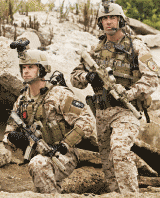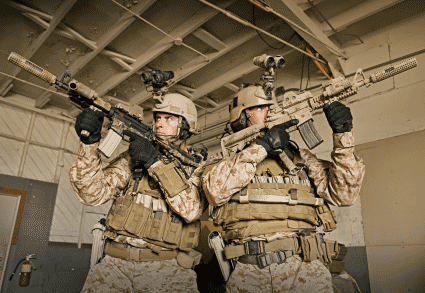Setting up an AR like a “high speed, low drag” Special Forces operator’s M4, with the same optics, lasers, lights and accessories, is not as hard as it may sound, but it won’t be cheap or pretty, as discovered when we took a close look at two M4 kits belonging to a pair of US Navy SEALs (Sea Air Land).
Like all Special Forces operators (Spec Ops), the SEALs are issued M4A1s built by Colt and augmented with SOPMOD accessory kits. The SOPMOD (Special Operations Peculiar Modifications) program was started in 1989, but really didn’t kick off until 1993 when it was given a directive to “…adapt [the] basic issue weapons to meet SOF (Special Operations Forces) mission-specific requirements.” The M4A1 carbine is a very basic platform. It’s really nothing more than an M16A2 with a 14.5-inch barrel, a detachable carrying handle on a Mil-Std-1913 Picatinny rail upper receiver and a full-automatic selector instead of a three-round burst selector. The various optics, rail forends, IR infrared lasers, night vision scopes, weapon lights, stocks and other accessories that we now associate with a tricked-out M4 all derive from the original SOPMOD kit.
 SOPMOD Kits
SOPMOD Kits
It’s important to note that the SOPMOD kit for an M4 is a constantly evolving bundle of accessories that is continually being updated as new and better technological improvements come along. The program’s term for newly added accessories is “phased replacement.” For example, the TangoDown BattleGrip vertical grip that’s currently included is a “phased replacement” for Knight’s vertical grip that was in the original 1995 kit.
Advertisement — Continue Reading Below
The basic purpose of these upgrades to the M4A1 5.56mm Carbine, quoting from an official description of SOPMOD, “Because Special Operations Forces lack organic heavy weapons such as tanks and artillery and are limited in capacity to carry or resupply ammunition, success and survival often depends on the effective employment of individual weapons.
“Items contained within the SOPMOD kit enhance the weapon’s operational effectiveness through increased target recognition/acquisition, speed of engagement and accuracy from Close Range Engagements to the maximum effective range of the weapon during both day and night conditions. Within these mission areas, the SOPMOD Program is responsible for the full spectrum of research and development, acquisition and SOF war fighter support.”
In a shorter and more to-the-point definition, SOPMOD program manager Gus Taylor said the purpose of the program is to, “Increase the operator’s survivability and lethality by enhanced weapon performance, target acquisition, signature suppression and fire control.”
Advertisement — Continue Reading Below
The SOPMOD kit is actually made up to accommodate four M4A1s, not one per gun as might be assumed. For instance, there is only one SOPMOD-improved M203 grenade launcher in each kit. In case you’re wondering, a SOPMOD M203 is basically a standard M203 but with a 9-inch barrel instead of the standard 12-inch tube, built by Knight’s Armament.
 SEALs’ Guns
SEALs’ Guns
The first thing you notice about the guns of the SEALs, and all Special Forces guns for that matter, is that no two M4s are alike. The reason is because the operators are given great latitude to set up their weapons to their own liking so they assemble their guns from whatever gear suits their fancy, a mix of old kit from earlier SOPMOD components still in the armory plus various “phased replacement” accessories. Of course, the operators are not above adding non-issue items that they’ve either bought themselves or traded with other operators.
SEALs seem to accessorize their M4s with a greater assortment of individualized gear than other Spec Ops operators. Adding to their gun’s character, they spray paint their M4s in colors and patterns for various mission requirements, all carried out with their own artistic sense.
Advertisement — Continue Reading Below
The M4s from the deploying SEALs that we were able to examine come in Hardigg StormCases. The full-length rifle cases are issued to each team member and contain his personal weapons and kit, namely an M4A1, a SIG SAUER P226 pistol, night vision and various other accessories.
Their M4s came with two uppers, one with a standard M4A1 length of 14.5 inches and a compact upper with a 10.5-inch barrel. The shorter-barreled upper is intended for CQB (close quarter battle)missions, cave clearings and such, while the 14.5-inch upper was for patrolling and reconnaissance missions where longer distance shots would be expected.
Both are flattops and set up with optical sights. The short-barrel upper is equipped with a L-3 EOTech 553 Holographic Weapon Sight, designated as the SU-231 PEQ, which is issued with the current SOPMOD kit. The forend is a Rail Interface System (RIS) from Knight’s Armament, fitted with Insight Tech-Gear’s ATPIAL (Advanced Target Pointer/Illuminator/Aiming Light) infrared laser/illuminator on the right quad rail. The ATPIAL is activated by a pressure switch fitted to a TangoDown BattleGrip vertical foregrip.
Advertisement — Continue Reading Below
The stock on the M4A1’s lower receiver is a “Crane stock” as made by Lewis Machine & Tool. The pistol grip is the standard GI-issue as made by Colt. Moving to the long-range upper, the 14.5-inch version is glassed with an ELCAN SpecterDR telescopic sight, designated as the SU-230 PVS. This optic is unusual in that it switches from 1x to 4x with a throw of a lever, unlike typical variable powered optics with dial-up progressively through the magnification range. The Specter’s reticle and center-dot can be illuminated independently. The reticle is also calibrated with hold-over lines matching the ballistics of the 5.56mm NATO round from 200 to 600 meters. The ELCAN SpecterDR is issued with the current SOPMOD kit.
This particular upper is a classic SEAL weapon in that it also sports non-SOPMOD-issue accessories. Onto the issue Knight’s RIS forend is affixed a machined aluminum CQD grip from Duane Dieter. There is also a Harris bipod. The upper is topped off with a SOPMOD-issue Knight’s QD sound suppressor.
 SEALs’ Kits
SEALs’ Kits
The two kits are painted with red numbers on all their components to identify their owners. Kit #4 is well worn with not much of its desert-colored spray paint remaining. Contrast that beat-up weapon to the pristine newness of the kit belonging to SEAL #16 and you’d wonder why there’s such a difference. Well, kit #16 belongs to a SEAL who is a machinegunner, and consequently all his pre-deployment work-up has been with his belt-fed and not his M4. SEAL #4, on the other hand, is an assaulter, so all his work has been with his M4 as his primary.
Advertisement — Continue Reading Below
In its freshly painted trim, the M4A1 belonging to #16 is set up with the same two-upper configuration with a couple of exceptions. There is no Harris bipod on this long-range upper but it does sport TangoDown rail covers on its Knight’s RIS forend. It comes with an issue Colt back-up iron sight whereas #4 has no BUIS (back-up iron sights). Both have the L-3 EOTech HWS on the shorter barreled CQB upper and the ELCAN SpecterDR on the upper.
The #16 long upper also sports an old Insight PEQ-2, which dates back to the original SOPMOD kit from 1995. Additionally, this upper has an original Knight’s vertical grip, again dating to the first SOPMOD kit. Lastly, #16 also seems to have scrounged a Trijicon ACOG (Advanced Combat Optical Gunsight) for his kit.
Both kits come with two sets of NVDs, (night vision device) an AN/PVS-15 dual-tube goggle and an AN/PVS-8 monocular. We can see that #16’s SIG SAUER P226 is fitted with a SureFire X200 WeaponLight while #4’s pistol came with both the X200 and SureFire’s older Military Model handgun WeaponLight.
Advertisement — Continue Reading Below
























